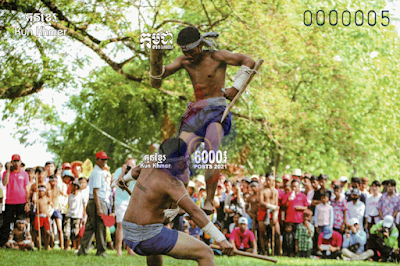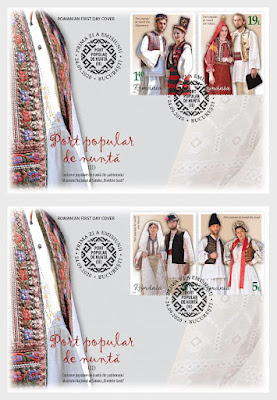Romfilatelia continues the series of postage issues with the topic Collections and introduces in the circulation on Friday, April 15th, this year, the issue Collections. Elisabeta Palace.
The issue, consisting of six stamps, six minisheets, a perforated souvenir sheet and two First Day Covers, associates with the folk costumes from the patrimony of Elisabeta Palace, the images of queens or princesses from the Royal Family of Romania and statuary elements, and on the First Covers, interior images of the Elisabeta Palace.
On the stamp with the face value of Lei 1.40 is illustrated a Folk costume distinctive for Pădureni region, first half of the twentieth century, household, worn by the Queen Elena. The main item of this costume is the neck-crinkle shirt, made of homemade thick cotton fabric, woven in two healds. The sleeve is the pičce de résistance of the item, the ornaments are made by sewing in old stitch, the decoration is of the panel type, on a black background, with colour dots in vegetable stylizations - it is an adult woman’s shirt. The chest is also adorned with two compact ornamental stripes. The collar repeats in a reduced pattern the decoration on the chest, and the sleeves are fastened in the bracelet with fodori (n.t. cuff made of crinkled fabric or embroidery, applied to sleeves) of fabric and with a lace edge. The poale (n.t. white skirt) feature homemade lace and a smaller decorative band made of white silk. The front and back poale are made of a fabric in 4 healds with hair warp and black wool weft; they are bordered by a black lace made with crochet. The two şorţ (n.t. apron) are fastened at the waist with a brâu (n.t. belt) woven in 4 healds, decorated with teeth from the nivideală (n.t. pass through the thread and reed, in the order required by the fabric pattern). The balţ was fastened over this brâu - which is a narrow leather belt adorned with small tin links, the fastening system being also made of tin in the form of a pair of paftale (n.t. belt buckles). A specific adornment is the chiciu with rings and rows of brass chains hanging over the front şorţ.
On the stamp with the face value of Lei 3.80 is depicted a Folk bridal gown distinctive for Argeş region, first quarter of the twentieth century, village workshop, by the Queen Marie. The shirt with altiţă (n.t. ornamental stitching on top of sleeve of traditional costume), of Carpathian type, consisting of trup (n.t. body) - made of 4 stani (n.t. sides), altiţă and sleeves. The altiţa is compact with a spaced row, the crinkle is decorative, sewn to the thread, the sleeves have a simple decoration, from a single pillar that resumes the motifs from the altiţa, the front and back are richly decorated with compact decorative stripes, the poale (n.t. white skirt) of the shirt are decorated with geometric motifs. The embroidery of the shirt is made of natural silk, metallic thread and tel - tinsel. The specific items of the traditional wedding costume are the peşteman (n.t. women’s clothing item made of dungaree or other lightweight material, which in some places in the country is wrapped like a skirt around the body) and the şorţ (n.t. apron). They are home woven in two healds, with a cotton warp and a wool weft. The ornaments are later sewn with silk, wool and metallic thread, in a geometric decoration. The brâu (n.t. woven belt) is woven in the same way as the peştemean, and the şorţ is woven in cotton and wool, repeating the motifs sewn on them.
On the stamp with the face value of Lei 3.90 is represented a Folk costume distinctive for Vrancea region, first quarter of the twentieth century, household, worn by the Queen Elisabeta.. The shirt with altiţă (n.t. ornamental stitching on top of sleeve of traditional costume), of Carpathian type, consisting of trup (n.t. body) - made of 4 stani (n.t. sides), altiţă and sleeves. The altiţe comply with the zonal specifics, having vertical rows of motifs separated by narrow strips of metallic thread and tel (n.t. tinsel). The sleeves have a compact panel-type decoration, fastened at the ends in the cuff, the front and back are decorated with decorative strips that represent little skipped pui (n.t. small decorative stitch in the shape of crosses), the poale (n.t. white skirt) of the shirt is not decorated. The embroidery of the shirt is made of cotton, metallic thread, tel, wool and natural silk. The fota (n.t. rectangular wool fabric replacing skirts) is woven in four healds with cotton warp and silk weft, made of two widths of fabric. The ornaments are made over threads with geometric motifs made of metallic thread and coloured silk, being grouped in vertical vergi (singular: vergea) (n.t. lap rods) called vârste (n.t. ornament consisting of stripes of a different colour). The top and bottom of the item feature a compact red warp band called a bată (n.t. the edge of the cloth, which, being particularly coloured from the rest of the fabric, is taken out of the fabric, when cut, and is used as a waist belt.). The brâu (n.t. belt) is woven in two healds with hair warp and metallic thread.
A Folk costume distinctive for Muscel region, traditionally inspired coat, first quarter of the twentieth century, village workshop, is illustrated on the stamp with the face value of Lei 4, worn by the Princess Ileana. The main item of the costume is the shirt crinkled at the neck, consisting of trup (n.t. body) - made of 4 stani (n.t. sides) and sleeves. The sleeves have a panel-type decoration consisting of rows of meanders with vegetable stylizations, the front and back are richly decorated with decorative stripes that repeat the motifs on the sleeves, the poale (n.t. white skirt) of the shirt are decorated with the same motifs. The embroidery of the shirt is made of cotton and metallic thread. Specific is the homemade fabric with orange edges used to manufacture the shirt and the poale, woven in two healds with thin cotton warp and weft. The fota (n.t. rectangular wool fabric replacing skirts) is woven in four healds with cotton warp and silk weft. The ornaments are made over threads with geometric motifs made of metallic thread and coloured silk. The brâu (n.t. belt) is woven in four healds with cotton and metallic thread warp and wool weft. The coat copies the clothes of the coachees specific to the southern part of the country, rich in ornaments made of wool and silk braids. The support material is the aba (n.t. thick wool fabric) and the rich ornaments are made of silk brandenburgs, the cut is wide, on the back it has a closing system with baiere (singular: baieră) (n.t. string, woollen braid to which something is attached or tied), and on the shoulders it has an open hood.
A Folk costume distinctive for Vâlcea region, first quarter of the twentieth century, household, is depicted on the stamp with the face value Lei 6.50, worn by the Princess Mărioara. The main item of the costume is the shirt with altiţă (n.t. ornamental stitching on top of sleeve of traditional costume), of Carpathian type, consisting of trup (n.t. body) - made of 4 stani (n.t. sides), altiță and sleeves. The altiţa is compact with a spaced row, the crinkle is decorative, sewn to the thread, the sleeves have a panel-type decoration, the front and back are richly decorated with compact decorative stripes, the poale (n.t. white skirts) of the shirt are decorated with geometric motifs. The embroidery of the shirt is made of cotton, metallic thread and tel - tinsel. The vâlnic (n.t. wollen kilt) is home woven in two healds, with cotton warp and wool weft. Specific to the region is the decoration of this item, made by alternating on the black background of some decorative strips made by dot stitches and lines made through the alesătură (n.t. fabric adorned with flowers and designs). The brâu (n.t. belt) is woven in two healds with cotton warp and weft, and the alesături are made of straight metallic thread.
On the stamp with the face value of Lei 15.60, is depicted a Folk costume distinctive for Romanați region, first quarter of the twentieth century, household. The shirt with altiţă (n.t. ornamental stitching on top of sleeve of traditional costume), of Carpathian type, consisting of trup (n.t. body) - made of 4 stani (n.t. sides), altiță and sleeves. The altiţa is compact with a spaced row, the crinkle is decorative, sewn to the thread, the sleeves have a panel-type decoration, the front and back are richly decorated with compact decorative stripes, the poale (n.t. white skirts) of the shirt are decorated with geometric motifs. The embroidery of the shirt is made of with natural silk, metallic thread, tel (n.t. tinsel) and sequins. The collar of the shirt is adorned with a row of embroidered cloth. The vâlnic (n.t. wollen kilt) is home woven in two healds, with cotton warp and wool weft. Specific to the region is the manufacture of the vâlnic from two widths of fabric, of red colour - the background, and the alternation of some polychrome ornamental vergi (singular: vergea) (n.t. lap rods) accompanied by rows of alesături over the threads.
On the perforated souvenir sheet of the issue, having the stamp with the face value of Lei 32, is illustrated a Folk costume distinctive for Olt region, first quarter of the twentieth century, household. The main item of the costume is the shirt with altiță (n.t. ornamental stitching on top of sleeve of traditional costume), of Carpathian type, consisting of trup (n.t. body) - made of 3 stani (n.t. sides), altiță and sleeves. The altiţa is compact, made by superimposing three geometric decorative registers, the crinkle is decorative, sewn to the thread, the sleeves have a decoration consisting of three râuri (n.t. decorative element in the Romanian folk costume, sewn in vertical rows on the ia, shirts, coats) made from the alternation of the rhomb in the altiţa, the front and back are richly ornamented with decorative stripes that resume the motifs of râuri, the poale (n.t. white skirt) of the shirt are decorated with geometric motifs. The embroidery of the shirt is made of cotton and metallic thread. The vâlnic (n.t. wollen kilt) is home woven in two healds, with cotton warp and wool weft. Specific to the region is the decoration of this item, made by alternating on the red background of the item some decorative strips made by alesătură (n.t. fabric adorned with flowers and designs) by hand in the Karamani technique.











































